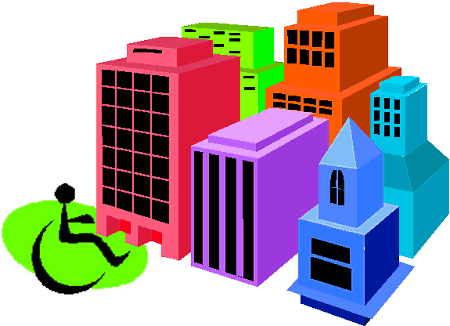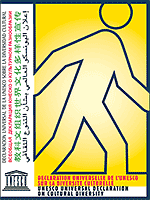|
Towards
a
Sustainable Social Environment
|

Accessibility-for-All
& Facilitation Design
(2001
WHO ICF)
Bookmark
this Page: www.accessibility-for-all.eu
Social
Environment
The complex network of real and virtual human interaction
– at a communal or larger group level – which
operates for reasons of tradition, culture, business, pleasure,
information exchange, institutional organization, legal
procedure, governance, human betterment, social progress
and spiritual enlightenment, etc.
The Social Environment shapes, binds together, and directs the future development
of, the Built (including Virtual) Environment.
A
Community-Centred approach to Spatial Planning
must, once again, become the norm.
Social
Wellbeing for All
A general condition - in a community, society or culture
- of health, happiness, creativity,
responsible fulfilment,
and sustainable development.
C J Walsh
2004
Rio de Janeiro Declaration on
Sustainable Social Development, Disability & Ageing
Adopted
11th December, 2004
Click
Here to View

UNESCO
2001 Universal Declaration on Cultural Diversity
(French, English, Spanish, Russian, Chinese, Arabic)
Click Here to Download PDF
(PDF File, 789kb)
United
Nations
1995
Copenhagen Declaration on Social Development
Click
Here to Download PDF
(PDF File, 309kb)
February
2000
European Parliament - Working Paper PE 168.629
Fundamental
Social Rights in Europe
Click
Here to Download PDF
(PDF File, 185kb)
| Facilitation
Design |
| An ethical, rights-based approach to design, targeted at the elimination of Participation Barriers and the insertion of Environmental Factors which improve a person's activity and functioning, or reduce his/her disability, in the Built, Social or Virtual Environments. |
Facilitator
(2001 WHO ICF) |
| Any
environmental factor which, through its presence or
absence, improves activity and functioning, or reduces
disability. |
Environmental
Factors
(2001
WHO ICF) |
| Those
factors which are external, or extrinsic, to the context
of a person's life and living situation, e.g. the built
environment and its features (real / virtual), other
people in different roles, social attitudes and values,
services, systems and policies. |
Personal
Factors
(2001
WHO ICF) |
| Those
factors which are internal, or intrinsic, to the context
of a person's life and living situation, e.g. age, gender,
level of education, socio-economic status, and life
experiences, etc. |
| Facilitation
Aid |
| Any
product, device or system - at the level of an individual
person - which improves activity and functioning, or
reduces disability, e.g. a wheelchair or walking stick. |
European
Union 2003 (EYPD) Expert Group on Accessibility
Established
by the European Commission - DG Employment & Social
Affairs
for 2003 - European Year of People with
Disabilities (EYPD)
C J Walsh is a Member of this Group
In
co-operation with
|
|
|
Sustainable Internet Services, Ireland |
We provide the following expert professional services:
Accessibility
Surveys, Audits & Impact Assessments
Accessibility Design & Implementation
Accessibility Training & Education Courses
Disability
Policy Implementation
Anti-Discrimination Proofing (Disability) of Organizations
Accessibility-Related
....
Fire Engineering
Design & Consultancy
Industrial Product Design
Independent 3rd Party
Inspections & Verification
Spatial Planning at Regional Levels
New,
Existing & Historical Buildings
Golf Courses, Outdoor Sports Facilities, Swimming Pools
& Amusement Parks
e-Accessibility
of Electronic, Information & Communication Technologies
(EICT's)
Full Integration into Quality, Safety at Work &
Environmental Policies
For more information about these services, please contact
us directly.
Model
Disability Policy Statements
| Employer
Organisation |
Regional
or Local Authority |
Educational
Establishment |
Contact
Us
(PDF File 51kb) |
Contact
Us
(PDF File 52kb) |
Contact
Us
(PDF File 51kb) |
In the event of any Legal Action being
taken by a Plaintiff ......
'
It shall be for the respondent to prove that there has
been no breach
of the principle of equal treatment.'
Article
10 of EU Directive 2000/78/EC
2nd
December 2003
Date for Implementation of this Directive in all EU Member
States.
Any existing anti-discrimination legislation must also
be made consistent with the new Directive.
European Agency for Safety & Health at Work - EASHW
EASHW Network - People with Activity Limitations
EASHW FactSheet No.53 - 2004
Ensuring the Health & Safety of Workers with Disabilities
Click Here to Download PDF
(PDF File, 356kb)
|
The
Disability Manual
Bearing
in mind the Burden of Proof in
European legislation ..... Recruitment, Work &
Promotion Practices at all levels of an Organization
must be documented in a Disability Manual.
Because
of the Social Stigma still attaching
to disability, some people may not wish to identify
themselves as having an impairment; other people
may genuinely not know that they have one.
Workers
at all levels of an Organization, who can readily
be identified as 'people with activity limitations',
must comprise 5% Minimum of the Workforce.
This
is a reasonable Disability Employment
Quota, as even the oldest and most unreliable
data in Europe suggests that 10% of any population
comprises 'people with activity limitations'.
Update June 2007: However .... more recent Statistics from EuroStat suggest that
20% of any population comprises 'people with activity limitations'. And for the purpose
of Fire Safety in Buildings, a Workforce figure of 10% Minimum should be used.
A
Quantified Employment Quota is
required for the purposes of Adequate
Accessibility Implementation.
Good Employment is an Important Key to
Social Inclusion.
Fulfilling and meaningful - not menial - employment
must therefore be provided for 'people with activity
limitations'.
To
ensure that there is Equal Employment
Opportunity, special recruitment and
promotion procedures will be required. Special
training courses may be necessary.
Important
Reasons for an Organization to Implement a Disability
Policy
1. Corporate Social Responsibility
European
Commission - DG Employment & Social Affairs
European
Commission - DG Enterprise
European
Commission - DG Trade
2.
Strategic
Movement Towards the 'Creative' Workplace
Click
Here to Download PDF
(PDF File, 29kb)
Stress at Work & Mental Health
|
European
Union Policy Framework
Achievement
of Equality of Opportunity & Social Inclusion
For Every Person in the European Union (E.U.)
(Refer to EU Council Resolution 97/C 12/01)
Preferred
EU Organization Framework
Click
Here to Download PDF
(PDF File, 65kb)
A
New European Context for Accessibility : 2010
This
New Context Requires Continual Re-Assessment.
People with Activity Limitations
Those
people, of all ages, who are unable to perform, independently
and without aid, human activities or tasks - because of
a health condition or physical / mental / cognitive / psychological
impairment of a permanent or temporary nature.
Harmonized
EU Vocabulary on 'Disability & Perception'
(April 2002)
Click
here to Download PDF
(PDF File, 113kb)
| Accessibility
of a Building |
Ease
of independent approach, entry and/or use of a building
and its services and facilities, by all of the building's
potential users ~ with an assurance of individual Health,
Safety and Welfare during the course of those activities.
|
which
must be overlaid by ....
| Accessibility
of the Built & Virtual Environments |
Ease
of independent mobility throughout the built and virtual
environments, and/or use of the facilities, services
and information available in those environments, by
any person or group of people ~ with an assurance of
individual Health, Safety and Welfare, and group Wellbeing,
during the course of those activities.
|
Protection of People with Activity Limitations from
Fire in Buildings
Disability
- Towards a Common European Technical Agenda
| The
Accessibility Cycle |
Why
not think of accessibility as a dynamic process - as
a continuous 'cycle' - which it is in reality ?
And
why not also look at accessibility of the 'built' environment
as a whole - including buildings, and transport, and
streets, and infrastructure, etc ?
Afterall
.... there is no rational or logical reason why transport
should be treated separately from the rest of the 'built'
environment - whatever the institutional arrangements
in Brussels, or at national level in the EU Member States. |
Accessibility Impact Assessment
A continual evaluation and optimization process - informing initial decision-making, or design, and shaping activity/product/service realization - of the interrelated negative impacts of Participation Barriers and Restrictions and the positive impacts of inserted Environmental Factors in the Built, Social or Virtual Environments.
Accessibility
: 2010
&
Priority Targeting for Concerted Action in Europe
|
List
A
'Survival
& Liberation' |
-
Residential
Buildings
-
Public
Transport
-
Educational
Buildings
-
' Workplaces'
|
|
|
List
B
'Health & Social Wellbeing'
|
-
Health
Facilities
-
Electronic,
Information & Communication Technologies
-
Civic
Buildings with a Voting / Voter Registration or
Judicial Function
-
Buildings of Historical, Cultural or Architectural
Importance
|
See
Principle 9 in the
2004
Rio Declaration on Sustainable Social Development, Disability
& Ageing |
- Accessibility EuroCode
- A Harmonized European Code of Design, Construction &
Management Practice for Spatial Planning & Infrastructural
Works, Buildings & the 'Workplace', Protection from
Fire in Buildings, and Transport
Accessibility
Matrix
(PDF File, 32kb)

See
Proposed Revision to EU Directive 89/106/EEC
Accessibility
EuroCode - Contents & Format
(June 2003)
Click
here to Download PDF
(PDF File, 53kb)
In building design and detailing, opportunities
to depart from the 'straight line' and 'right-angle'
should be fully explored. A building's internal spaces
should be designed or modified to be of human scale;
its general arrangement, layout and facilities should
be easily understood by building users; and a ready
connection with the exterior should be provided throughout
its extent. The building's associated external spaces
should be properly designed, and should relate to
the internal plan and function. It should be possible
for a person to find his/her orientation in a building
without difficulty. The building's circulation spaces
should be well lit, and should be designed to positively
encourage social interaction. Good architectural design
and immediately understandable sensory cues should
be used in preference to signage. Adequate provision
should be made for people to personalize their educational
/ living / work spaces, and to control the environmental
conditions within those spaces.
Announcing a New Computer Software Package
Proto-Access - 2007
Click Here to Download a Brief Description
(PDF File, 38kb)
- Accessibility
EuroCode - Also Incorporating Facilitation Design
of a Sustainable
Virtual Environment (including Electronic, Information
& Communication Technologies - EICT's)
e-Accessibility
Matrix
Click
here to Download PDF
(PDF File, 60kb)

Sustainability e-Label
It
is our policy to improve, and to constantly review,
the accessibility of this WebSite. For an example of
our current approach to e-Accessibility, go to our HomePage.
- Archive:
Elimination of Architectural Barriers to Mobility of Disabled
People in Residential Buildings - RIAI / AOTI
1990
Accessibility of residential buildings, public transport, educational buildings and 'workplaces' requires priority and targeted implementation in the European Union. Until now, talk has been very cheap !
See # 1 above. |
-
Comparitive Matrix between 1991 Fair Housing Accessibility
Guidelines (HUD - USA) and the following US Model Building
Codes
ICC - International Building Code (1997 first draft)
BOCA - National Building Code (1996 edition)
ICBO - Uniform Building Code (1997 edition)
SBCCI - Standard Building Code (1997 edition)
Click Here to Download
(PDF File, 313kb )
- A
Typical Architectural Detail Produced by This Practice
For
example ..... a ground supported concrete floor slab /
slab on grade / floating slab.
Application
..... typically Europe - outside Seismic Zones !

Detail
of Junction at Ground Floor and External Wall
This detail incorporates Radon Protection Measures,
High Thermal Performance, an allowance for Construction
Settlement, and a flexible approach to Accessibility.
-
All
Entrances and Fire Exits Should Have Level Access
/ Egress
If there is a threshold sill at an entrance /
exit doorset, it should not have a height greater
than 10mm.
-
Uneven
External Ground Level or Where the Final Level of
External Ground Cannot be Precisely Determined
The approach to the level circulation space (clear
area of 1.800m x 1.800m) in front of an entrance,
or the route away from the level circulation space
outside an exit, may be easily sloped or ramped (max.
gradient 1:20) in order to deal with the 75mm difference
between internal and external levels shown above.
Installation of a damp proof course (DPC) in the external
leaf of the cavity wall, at a position approximately
150mm above external ground level in a separate horizontal
joint, is an option for the architect to decide upon.
A projecting canopy over the door opening and associated
external circulation space, or recessing the door
opening and associated external circulation space
under a floor above, will provide weather protection.
To aid surface water run-off, the external circulation
space associated with a door opening may incorporate
a very slight slope (max. gradient 1:50) away from
the opening. You now have level access / egress.
-
Where
Even External Ground Level Can be Precisely Determined
Considering a very slight slope (max. gradient
1:50) to aid surface water run-off, drop the internal
level shown above by a dimension to be calculated
by the architect. Install a damp proof course (DPC)
in the external leaf of the cavity wall, at a position
150mm above external ground level. You now have level
access / egress.
-
Important
Note Concerning Thermal Insulation in Buildings
Conscious that the Construction Sector in the European
Union must implement
a dramatic improvement in performance, if its legally
binding commitments
under the 1997 Kyoto Protocol are to be fulfilled -
every opportunity must be taken
to maximize levels of thermal insulation in new buildings.
The insulation shown in the detail above is expanded
polystyrene.
Underfloor insulation should have a minimum density
of 25kg/m3.
-
Under
no circumstances should a Radon
Resisting Membrane exit a building below external
ground level

|
You will need Adobe Acrobat
Reader to view the PDF files. Accessibility
of PDF for people with disabilities |
©
Sustainable Design International Limited 1995-2018
all rights reserved - tutti i diritti riservati
|




